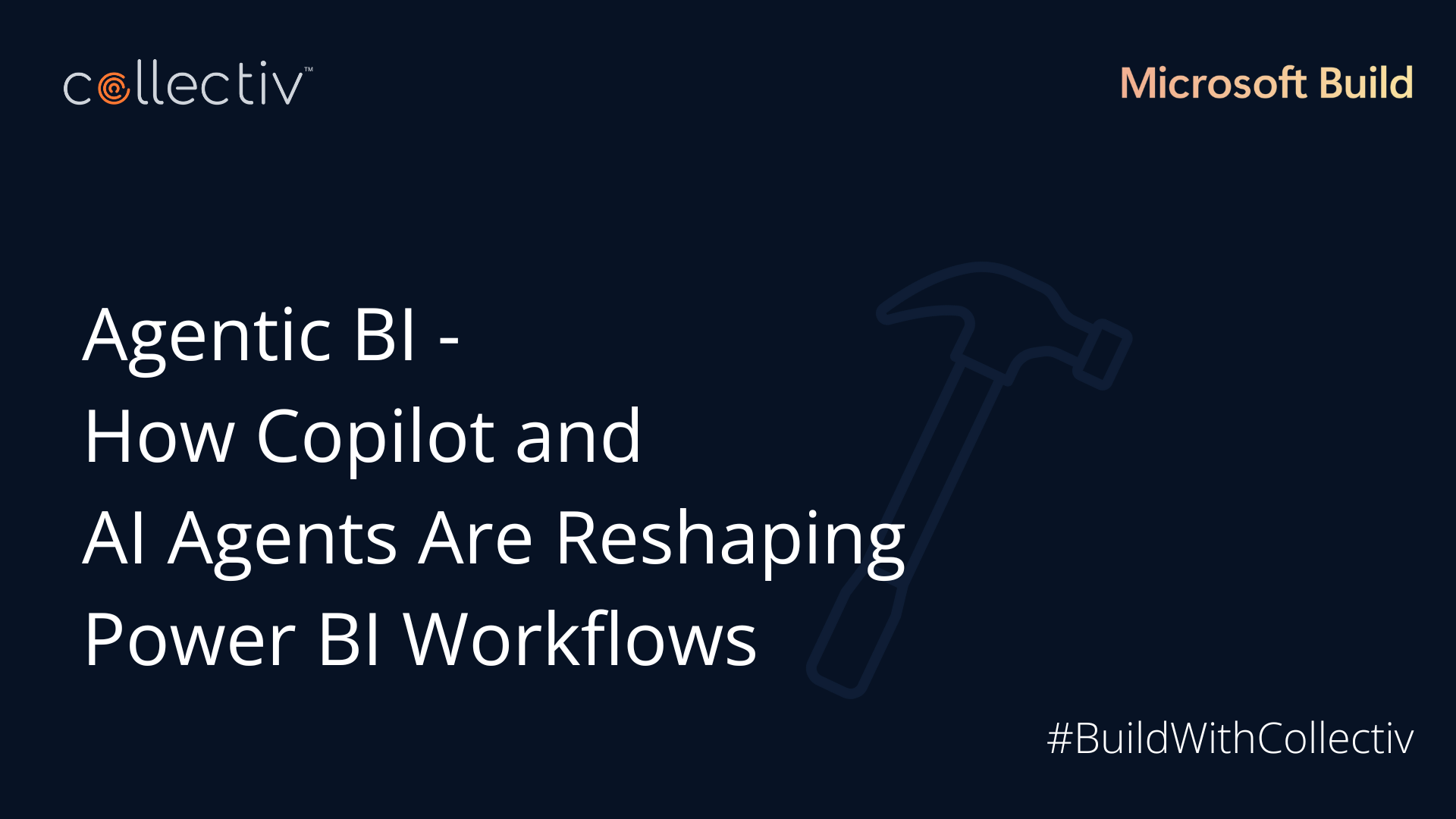Data governance is one of those buzz terms that I feel is always surrounding the Power BI environment. Our clients often ask us: How do you define data governance? The follow-up question is usually: How do you make sure you have data governance success within your organization?
Successful data governance really revolves around having standards, policies, and procedures in place then making sure these standards, policies, and procedures are followed consistently by business units and led passionately by the executive leadership team.
Data governance tools, like Power BI Sentinel, are a phenomenal way to strengthen your data governance program. If you’re aren’t familiar with the capabilities of data governance tools, you’ll walk away with plenty of insights from Josh Stoltzfus today.
Josh is Redwood Credit Union’s Finance Manager and one of our long-term clients here at Collectiv. Today Josh shares his experience and expertise with his own data governance program, including his perspective on using Power BI Sentinel to support organizational efforts.
What is often overlooked in a data governance framework? And, what best practices do you recommend?
Driving accountability within the entire organization is something I think is overlooked by a lot of companies. When people think of data governance, they immediately think of their IT, finance, and analytic teams as being the sole contributors to the effort. To properly roll out a data governance framework, it’s a cultural initiative and everyone needs to be involved.
You need executive sponsorship then you need “bench strength.” Leadership and staff within the local departments outside of IT, finance, and analytics all play a big role in bench strength. It’s a change in mindset for the entire organization and that’s not an easy thing to pull off unless you get organizational buy-in.
To increase our bench strength at Redwood Credit Union, we created a network of data owners and data stewards in various departments. We selected 2-3 staff members to be the eyes and ears of the data governance team within their local department and understand their responsibility set.
If people don’t have the governance mindset, they will make a change to data without thinking about upstream and downstream impacts. All of a sudden, three or four reports in other departments can be impacted because of one data or system change that was made in a department on the other side of the organization.
You need a constant tether—assertive coordination and communication that happens every week with these folks until it becomes ingrained.
When you reinforce these key data governance principles and infuse those data owners and stewards locally, now the mindset is changing. And there is a cultural change across the company, as far as how the staff is thinking about the use of their data and potential implications of system or data changes.
How does an organization govern a “single version of the truth” and why is it critical?
Over the last 20 years, I can’t tell you how many times I’ve been in meetings where the CEO or CFO pulls up two identically titled reports yet they contain completely different data and conflicting messages—we call these “dueling dashboards.” Quite frankly, dueling dashboards make the executives’ heads want to explode because they greatly impair their confidence and trust when trying to make a decision.
If you have a single version of the truth, along with consistency with KPIs and key metrics, it greatly enhances your leadership’s ability to go out and make decisions more quickly. They don’t have to wonder which report is right or reconcile reports.
To avoid fighting dueling dashboard battles, here are some ways to govern single versions of the truth structurally within the organization:
- Be cautious of “shadow analysts” where different business units have their own analysts. If you have a decentralized analyst structure, ensure the analyst teams are aggressively communicating and collaborating.
- Sit down with business leaders to understand and define KPIs.
- Get leadership buy-in and alignment on the front end.
- Memorialize KPI definitions in writing after approval by the business leaders and lock them down after alignment happens.
- Have data owners and stewards across departments (mentioned in the previous section).
- Create an approval process for any time the business might evolve and KPIs change.
Why should organizations consider data governance tools?
Data governance tools are critical to ensure that you have a process to certify your data. That’s one of the things Power BI does really well. It has a way for users to know if the data has been vetted and certified—and if it can be trusted.
It comes down to understanding the state of your data and using a tool that bucketizes and certifies data. At that point, your data can be used in reports and published to the organization.
You can have the best analysts and the best BI tool in the world. But if your data is inaccurate and not governed properly, you won’t get to the right outcome.
How were you managing data governance prior to having a tool and what were the process issues?
That’s an easy question to answer…there was very limited data governance. My company, Redwood Credit Union, has an amazing and engaging brand that has been around for 70 years. However, data was not something our organization was good at five years ago and we certainly didn’t have much of a governance framework.
Before I joined the company, consultants came in and arrived at this overwhelming conclusion: “You guys suck at data.”
Luckily our organization provided world-class service, fostered a one-of-a-kind corporate culture, and possessed a CEO who excelled at strategy and critical-thinking. This same CEO astutely realized that service, talent, and skill alone can only get you by for so long. As the organization continued to grow in size and complexity, data had to be part of our strategy going forward.
We improved our data governance process by first getting strategy and best practice guidance from the Collectiv team. Step one was to aggregate all of the disparate data and systems that had popped up to support growing business lines over time.
In conjunction with data aggregation, we also recognized that we didn’t have anyone who had previously implemented a data governance framework from start to finish. Collectiv performed a general assessment of our data infrastructure and governance process. And we used a lot of their recommendations to guide the way forward.
What are the most valuable capabilities of a data governance tool like Power BI Sentinel?
Power BI Sentinel has a reports inventory capability built into it. This feature shows you who owns the report, when it was created, and when/if the report was modified or changed. If the underlying data was changed, Power BI Sentinel provides an audit record. That becomes incredibly important when you have hundreds of reports across your ecosystem.
Power BI Sentinel also tells you who is looking at various reports. If there is a fantastic report that nobody is looking at, you ask:
- Did we have a communication problem when we launched the report?
- Do we need to re-message then resend it?
- Or, do we need to sunset that report altogether?
Most organizations are overwhelmed with data and reporting—a lot of data and reporting ends up being counter-productive. Power BI Sentinel is this awesome tool that helps you organize and optimize your reporting ecosystem and data strategy.
How does Power BI Sentinel foster a data-driven culture?
Back to the cultural piece with those data owners and stewards…we’re using Power BI Sentinel to take stock of our entire company and the way we’re structured. We’re creating this data acumen/critical thinking scorecard where we have developed 3-5 questions for various departments across different criteria to score data competency.
We’re using Sentinel to learn about usage analytics habits, so that tool is helping us fulfill one of those criteria as we rank the group.
How does Power BI Sentinel enable the organization with usage analytics and why is that important?
You can create a dashboard in Power BI Sentinel that paints a picture of where you’re getting most of your usage, such as what areas of the business are accessing which reports.
So, I found that ability to actually use the Power BI reporting capability pointed back to the Sentinel data. We were able to get some pretty useful reports and dashboards that our governance team is using to inform analytics usage in the organization. Leveraging dashboards that provide a lens into which reports are being used the most by which staff is really powerful.
How can organizations optimize their investment in Power BI Sentinel?
The report ecosystem itself is worth calling out again. A lot of times you get duplicative efforts on reporting, with 2-3 people producing the same or similar reporting every month. You could also have someone developing a report that’s been around forever. Do they still need to be producing that report? Is the report still relevant?
These activities, if unmonitored, can be really inefficient and costly…but Sentinel helps you get right to the bottom of that. I mean, let’s identify which reports are out there and who is doing what, remove the unnecessary and redundant efforts in order to free up staff’s time and energy.
Being that Power BI Sentinel is a data governance tool that helps you optimize your data and reporting strategy—and save your resources—I think it’s a fantastic value.





























